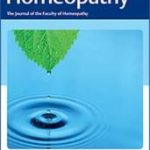Ana Carla C. Aparicio, Larissa Helen S. de Oliveira, Jefferson S. Silva, Cideli P. Coelho, Sonia Regina Pinheiro, Monica F. Souza, Ivana B. Suffredini, Steven J. Cartwright, Leoni Villano Bonamin
Interaction between Solvatochromic Dyes and Water Sampled from a Natural Source Treated with High Dilutions of Phosphorus
Homeopathy, 2020, 109 (3), 126-132

Background – Highly diluted and succussed solutions interact with solvatochromic dyes, indicating that changes in solvent and solute polarity could be related to their mechanism of action. It is not known, however, how the activity associated with succussed high dilutions is transferred to untreated water and what the limits of this process are. Aims – The aims of the present study were to ascertain whether a succussed high dilution of phosphorus (1.5 × 1−59 M; Phos 30cH) seeded into a natural water source that fed a fjord and two connected lakes could propagate itself through the lake system (total volume 2200 m3) and, moreover, whether the process could be tracked using solvatochromic dyes. Methods – Samples of water were collected before and after seeding, at different times and places throughout the lake system. Controls comprised water taken from an untreated and adjacent, but independent, lake (1385 m3). Results – Water samples taken up to 72 hours after the source treatment produced significant increases (p ≤ 0.03) in the absorbance of the solvatochromic dye methylene violet (MV), while samples from the control lake produced no changes. Conclusions – The study indicates that activity associated with Phos 30c can propagate itself through large volumes of water, causing changes throughout a whole connected lake system, and that these changes can be tracked using the solvatochromic dye MV. This in turn means the use of homeopathic medicines in large volumes of drinking water, in farming and ecological contexts, now has the potential to be assessed with physico-chemical monitoring.






Lascia un commento
Devi essere connesso per inviare un commento.